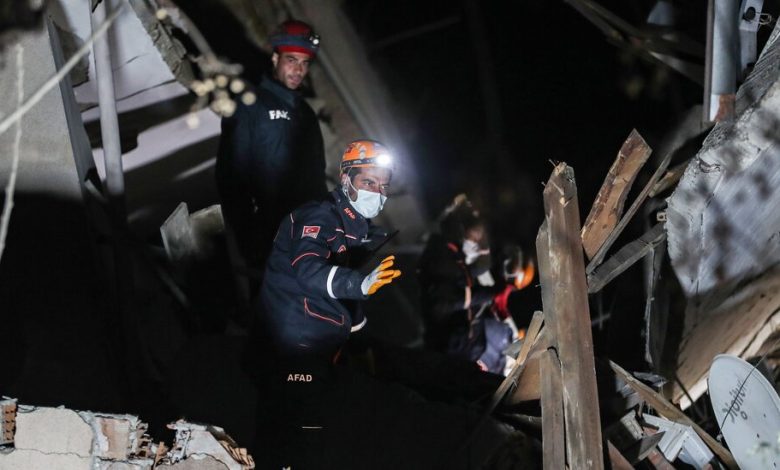Another Deadly Quake Rocks an Already Ravaged Area of Turkey

ISTANBUL — Just two weeks after the worst earthquake in more than 80 years devastated much of southern Turkey and northwestern Syria, another powerful temblor struck the same region on Monday, once again collapsing buildings and claiming lives, and sowing panic among millions of people already traumatized by disaster.
The quake struck at 8:04 p.m. in Hatay, Turkey’s southernmost province, and was measured at 6.4 magnitude by the European-Mediterranean Seismological Center and 6.3 by the U.S. Geological Survey. It was centered in one of the areas hardest hit by the Feb. 6 quake and its aftershocks, which flattened thousands of buildings, entombing victims in concrete and twisted metal, claimed at least 46,000 lives in Turkey and Syria, and left many more people homeless.
“All of sudden, I felt like the earth had been pulled out under my feet,” said Mehmet Ali Gumus, a lawyer in Samandag, a town on the Mediterranean coast, very close to the epicenter. “Such a strong quake, I don’t have words to describe it,” he said by telephone. “I could not even walk straight to the door just one meter away.”
At least three people were killed and 213 injured, said Turkey’s interior minister, Suleyman Soylu, but local officials say more are trapped in the rubble, their conditions unknown.
In the opposition-held area of northwestern Syria, at least 150 were injured, many of them trampled in a panicked rush to safety, but there were no confirmed deaths, according to the White Helmets, a civil defense group there.
The 7.8-magnitude quake two weeks earlier was the strongest to hit Turkey since 1939, and along with its thousands of aftershocks it is the country’s deadliest seismic event in modern history. Since then, many people across the region whose homes were still standing have been sleeping in tents, shipping containers and other makeshift shelters in frigid winter conditions, for fear that their structures were unsafe — a fact that may have saved lives on Monday as more buildings tumbled.
Turkish emergency workers had been winding down rescue operations as hopes faded of finding more survivors in the ruins of the earlier quake, only to be called on Monday to resume saving lives.
The disaster came hours after Antony J. Blinken, making his first visit to Turkey as U.S. secretary of state, had declared, “The United States is here to support you in your time of need, and we will be by your side for as long as it takes to recover and rebuild.” After the Feb. 6 earthquake, the United States sent search-and-rescue teams, heavy equipment, $85 million in humanitarian aid and $80 million in private donations, and Mr. Blinken announced an additional $100 million in aid.
The epicenter of Monday’s shock was just 10 miles southwest of the ancient city of Antakya, formerly known as Antioch, and even closer to Samandag, both already ravaged by the earlier quake. The epicenter was relatively shallow, just 10 miles underground, which makes for more intense shaking at the surface. Local officials said it felt just as powerful, if not more so, than the bigger Feb. 6 quake centered more than 80 miles from Antakya.
“We felt it much stronger” than the Feb. 6 quake, the mayor of the Defne district near Antakya, Ibrahim Guzel, told the broadcaster NTV. “There is no electricity.”
“People are screaming for their lives,” he added, and there were people trapped under the debris, as there were after the quake two weeks ago.
Refik Eryilmaz, the mayor of Samandag, told the broadcaster Halk TV, “the shelter problem is real,” and parents trying to survive with children out in the cold are tempted to return to unsafe buildings.
“One can’t put a police officer in front of every building,” he said, adding, “this could only be solved with more tents.”
Farther from the epicenter, in the city of Adana, people fled their homes toting young children, pets, a few clothes and blankets, to take shelter in gymnasiums, just as they did two weeks ago. “We only went home six days ago,” said Ibrahim Oguz. “Our morale is not great.”
Ulku Sahin said her daughter-in-law, who has cancer, was scheduled to receive treatment on Tuesday, and “I don’t know how she will be able to go inside.”
Turkish authorities warned people to stay away from damaged structures that could yet collapse.
“I’m trembling. We are all traumatized,” said Asu Askit, the wife of a hotel owner in the city of Adana. “I think I will stay in my car tonight.”
Lutfu Savas, the mayor of Hatay province, told NTV, “unfortunately, we are receiving messages about people remaining under buildings.” Some of the victims had returned to their homes, either in hopes that they were solid or to retrieve belongings.
Many victims of the Feb. 6 earthquake lived in modern high-rise apartment buildings they had believed were earthquake-safe, yet collapsed. That has fueled widespread anger at officials and contractors who skirted seismic building codes, prompting arrests of some builders. Opposition politicians have cast blame on President Recep Tayyip Erdogan, who already faced an uphill battle for re-election in a contest scheduled to be held in May.
Experts say recovery will mean not just removing debris and erecting new buildings, but reinforcing or tearing down those that remain but are unsafe, and it could take a decade.
Gulsin Harman, Safak Timur and Ben Hubbard reported from Istanbul, and Cora Engelbrecht from Adana, Turkey. Reporting was contributed by Nimet Kirac from Adana, Hwaida Saad and Raja Abdulrahim from Beirut, Elif Ince from Istanbul and Carly Olson from New York.
